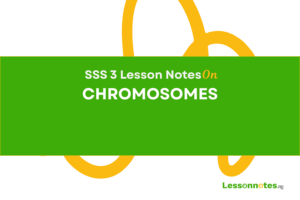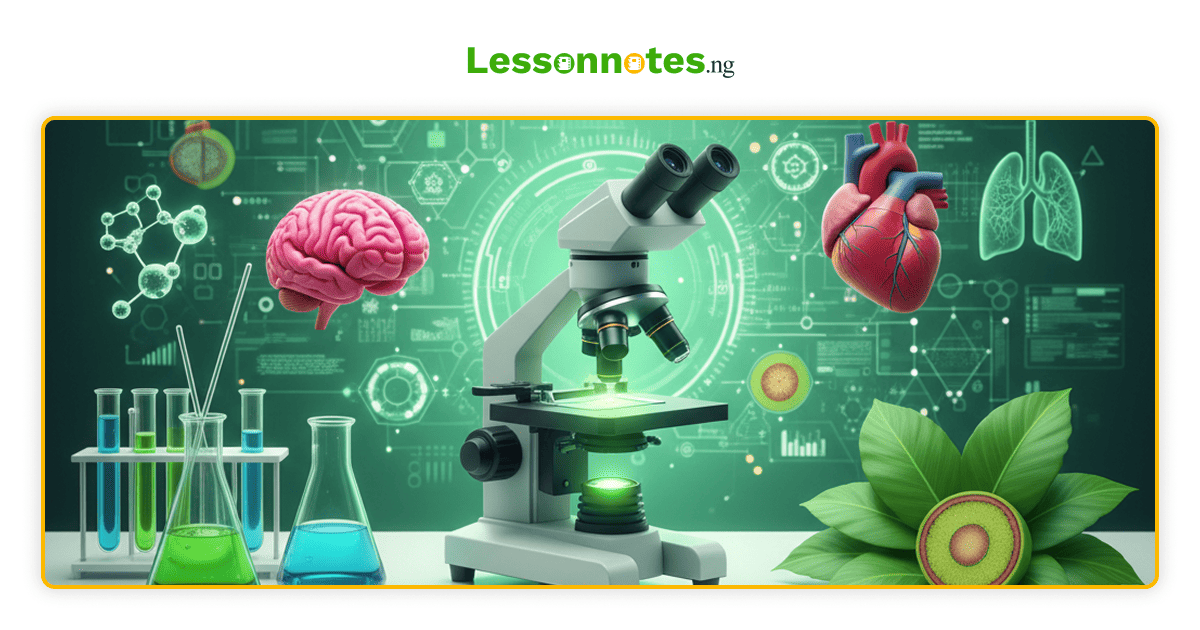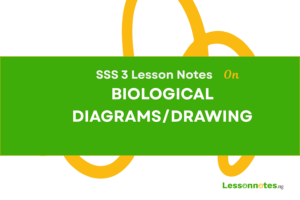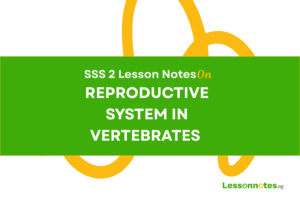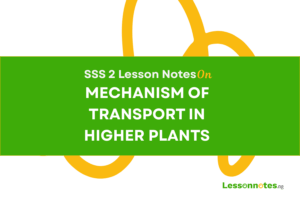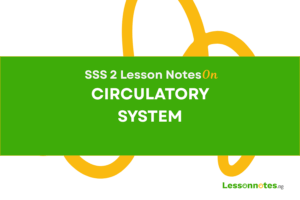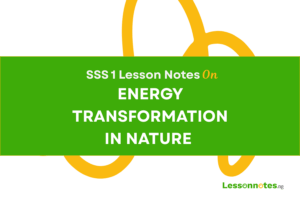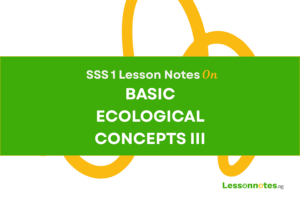Digestive System SS2 Biology Lesson Note
Download Lesson NoteTopic: Digestive System
FEEDING IN HYDRA
Hydra feeds on small aquatic organisms e.g. crustaceans. It captures its food through its structure called nematocysts found on its tentacles. The food is then passed into the mouth while the digestive enzymes are secreted into the enteron by the gland cells. The digestion is extracellular and the digested food is absorbed into the body while the undigested food is sent back into the enteron and released through the mouth. The digestion here is therefore intracellular and extracellular.

DIGESTION IN FLATWORM [TAPEWORM & PLANARIA]
Tapeworm is a parasitic worm which has no alimentary canal; it feeds on the digested food of the host. However, the planarian is a free-living flatworm which feeds on small animals. Planaria has a simple alimentary canal with one opening i.e. the mouth present in the ventral part of its body cavity. The pharynx of the planarian can be extended out of the mouth during feeding. The pumping action of the pharynx sucks in pieces of food which enter the pharynx and move into the small intestine. Digestion is partly extracellular and partly intracellular. The branched intestine enables the digested food to diffuse to all parts of the body while undigested food is ingested through the mouth.
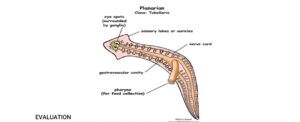
DIGESTION IN EARTHWORM
The alimentary canal of the earthworm is a tube with two openings:
- The mouth through which the food enters
- The anus through which the undigested food leaves the body
The alimentary canal of the earthworm has the following parts:
i. Mouth and thin-walled buccal cavity for food ingestion
ii. A muscular walled pharynx which secretes mucus to lubricate food particles
iii. A narrow tubular thin-walled oesophagus
iv. A thin-walled crop for storing food
v. A thin-walled muscular gizzard where food is ground against small stones to break it up.
vi. A long straight intestine in which extracellular digestion occurs.
Mechanism Of Digestion In Earthworm
The prostomium is the mouth of the earthworm. Since it has no jaws or teeth, the earthworm uses its muscular pharynx to suck in soil containing food. The food particles and soil go through a long oesophagus into a round organ called a crop. The crop stores the food temporarily. Then it is forced into a very muscular organ called the gizzard. The gizzard contracts and expands, causing grains of sand and food to rub together. In this way, the food is ground up. Food is digested in the intestine, which stretches from segment nineteen to the end of the worm. Here enzymes chemically break down the food. Then the digested food is absorbed by the blood circulating through the intestinal walls. The earthworm’s digestive system can be thought of as a tube within a tube.
The complicated organs of the digestive system take up most of the anterior half of the earthworm’s body. The earthworm ingests large amounts of soil, which has organic matter in it. The useless inorganic matter goes through the worm with no change. This is often left on the surface of the ground in the form of castings. As the earthworms feed, they loosen the soil, making it easier for air and water to enter. Their wastes also add to soil fertility. If there were no earthworms, the soil could not support crops, grasses, and other plants.
DIGESTION IN INSECTS
The alimentary canals of insects consist of three major parts:
- The foregut [mouth, pharynx, oesophagus crop, gizzard]
- Mid gut [stomach]
- Hind gut [intestine, ileum, colon, rectum, anus]
Insects such as grasshoppers feed on leaves. They use their mouth parts to cut and crush the leaves. Saliva is introduced or poured into the leaves from the salivary gland. The saliva helps to soften the leaves and the chewed food is in the crop, and broken up further into small pieces.
The foregut and the midgut secrete enzyme-rich juice into the midgut where digestion and absorption occur.
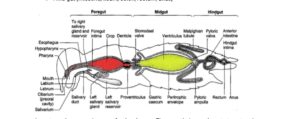
The hindgut is for water absorption. Only solid faeces pellets are egested from the anus after the food waste has been collected through the malpighian tubules joining the mid and hindgut.
DIGESTION IN BIRD
Birds do not have teeth but horny beaks which they use for feeding. In many birds, the feet also show adaptation for feeding.
The alimentary canal of the bird consists of the following:
- Oesophagus
- Crop
- Proventriculus
- Gizzard
- Small intestine
- Caeca
- Cloaca
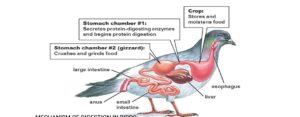
Mechanism Of Digestion In Birds
The bird swallows their food whole and stores it in the crop. In the crop, it is softened by secretion from the wall of the crop. It is then through the proventriculus to the gizzard where gastric juice churns the food and breaks it up into smaller units. This is preceded by the grinding action of the muscles of the gizzard [a strong muscular bag]. A small stone in the gizzard also assists in the grinding of the food. The digestion is completed in the small intestine by the action of intestinal and pancreatic juice. The absorption also occurs here and the solid waste passed through the anus into the cloaca.
DIGESTIVE SYSTEM AND DIGESTION IN MAN
Heterotrophic organisms get their food from their autotrophic counterparts or depend on other heterotrophic organisms.
The food is taken in (ingestion), and broken down into simple, soluble and diffusible substances through some chemical and mechanical processes. This is referred to as digestion. The digested food is eventually absorbed (absorption) into the body fluids and assimilated while the undigested food is removed (egested)
FEEDING AND DIGESTION MECHANISMS
All holozoic animals have structures for obtaining their food. The structures also help them to capture their prey. Those organisms feeding on large food particles have their bodies modified into structures like claws, teeth, beaks etc. However, those feeding on small pieces of food have either fluid-feeding or filter-feeding structures while saprophytes change their food to digested absorbable form before taking them in. Parasites on the other hand have structures for boring into the bodies of their host.
Most holozoic animals have a digestive pathway called the alimentary canal or gut, unlike unicellular animals. Their gut consists of two openings:
- Anterior opening called mouth
- Posterior Opening called anus
A typical alimentary canal is adapted for breaking food into smaller units, producing digestive secretions and absorbing digested food and water.
A digestive system is made up of an alimentary canal and the associated glands and organs which produce some of the enzymes-rich secretion that bring about digestion. The action of the teeth is the mechanical breakdown of digestion while the digestive enzymes speed up the chemical digestion.
DIGESTION OF FOOD IN HUMANS
Food passes through the following process in man:
Ingestion →Digestion →Absorption →Assimilation →Egestion
Food is ingested in the mouth and the teeth grind the food into smaller units, chemical digestion also begins. Saliva contains an enzyme, ptyalin that acts on cooked starch to convert it to complex sugar (maltose). Saliva is a watery, slightly alkaline substance secreted by the salivary gland.
The tongue mixes the food with saliva and rolls it into a ball (bolus) which is then swallowed. The food passes down into the stomach through the gullet (oesophagus). During swallowing of food, the entrance to the trachea must be closed to prevent choking. The wall of the oesophagus is muscular and it contracts and relaxes to push each bolus of food downward, this process is called peristalsis.
DIGESTION IN THE STOMACH
The muscular wall of the stomach contracts and relaxes forcefully just churning the food. The gastric juice mixes with the food. Gastric juice contains two important enzymes; pepsin and rennin as well as hydrochloric acid for activating pepsinogen into pepsin. Pepsin digests protein into peptones and polypeptides which are intermediate products in protein digestion. Pepsin works best in an acidic medium and the acid also assists in killing the bacteria present in food. Rennin causes the coagulation of milk into thick curd (converting soluble caseinogens to insoluble casein). Food stays in the stomach for about 3-4 hours.
DIGESTION IN THE SMALL INTESTINE
The first part of the small intestine is the duodenum; the pancreas secretes pancreatic juice which contains digestive enzymes. The liver produces bile, which is stored in the gall bladder. Bile is a greenish liquid that emulsifies fat, which does not contain digestive enzymes.
The pancreatic juice contains three important enzymes:
- Amylopsin converts starch to maltose
- Trypsin converts protein to polypeptides
- Lipase converts Lipids to fatty acids and glycerol
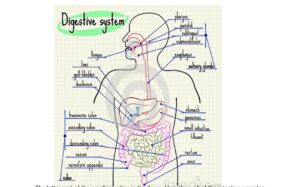
The latter part of the small intestine is the ileum. Here the wall of the intestine secretes five important enzymes:
- maltase – converts maltose to glucose + glucose
- Sucrase – converts sucrose to glucose + fructose
- Lactase – converts lactose to glucose + galactose
- Erepsin – converts polypeptides to amino acids
- Lipase – converts fats and oil to fatty acids and glycerol
In man the digestion of food ends in the small intestine. Hence the end product of protein is amino acids, fats and oil is fatty acid and glycerol while that of starch are glucose, fructose and galactose.
ABSORPTION AND ASSIMILATION
Glucose, amino acids, fatty or carboxylic acids and glycerol as well as vitamins and mineral salt are absorbed in the small intestine. For efficient absorption, a large surface area is needed. To ensure this, the wall of the small intestine has folds and furrows. Also, there are finger-like projections called villi (Villus). The inner surface layer (epithelium) of each villus is thin.
This allows the absorption of the end products of digestion which takes place by either diffusion or active transport. The absorbed food substances are carried away through the blood vessels and lymphatic vessels (containing blood and lymph respectively).
In each villus, there is a blind lymphatic tube called lacteal which is surrounded by a network of blood capillaries. The lymph in the lacteal transport fatty acid (carboxylic acid) and glycerol which recombines to form fats in the lacteals. This is then carried by the blood to where they are needed. Excess fats are stored in fat cells to form adipose tissues which are usually found under the skin and around organs.
FEEDING MECHANISMS
- Filter Feeding: This concerns mainly aquatic animals which feed on very tiny organisms in water. They use their sieve-like structure to collect their food or prey. Examples of filter feeders are mosquito larvae, ducks, prawns etc.
- Fluid Feeding:This concerns animals which feed on fluid materials and so they are called fluid feeders. They include classes of animals namely:
(a) Sucker e.g. bugs, mosquitoes, butterflies, houseflies, tsetse fly etc.
(b) Wallowers:These are organisms which wallow in their food e.g. tapeworms. Tapeworm lives within the digested food of its host and absorbs the food directly into the body. Therefore, it does not have an alimentary canal. The absorption of its food is through its entire body surface.
MODIFICATION AND MECHANISMS OF FEEDING IN ANIMALS
This can be studied in five mechanisms:
- Absorption mechanisms e.g. tapeworm
- Biting and chewing mechanisms e.g. grasshopper
- Sucking mechanisms e.g. mosquitoes
- Grinding mechanisms e.g. Man
- Trapping and absorbing mechanisms e.g. bladder worm.
ASSIGNMENT
- State the region in the alimentary canal where the chemical digestion of the following food substances begins(a) Carbohydrate (b) Protein (c) Lipids
- What role does pancreatic juice play in digestion?


